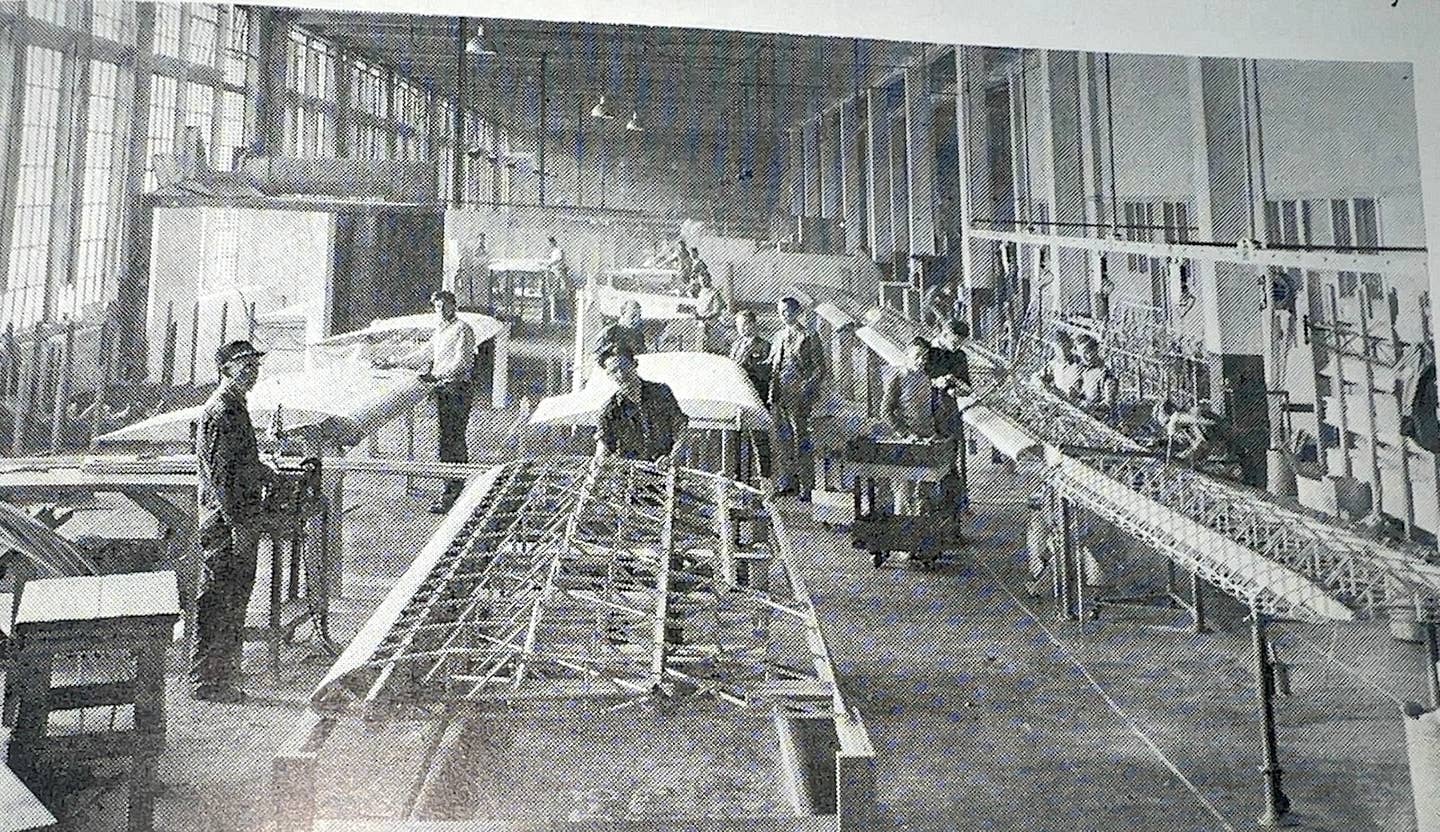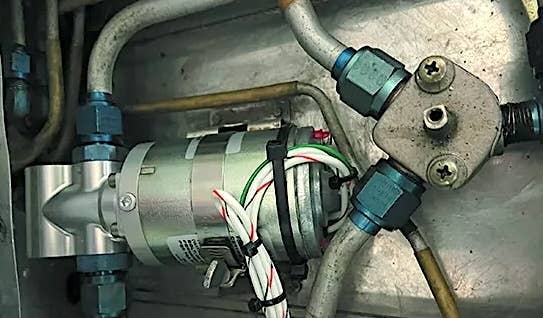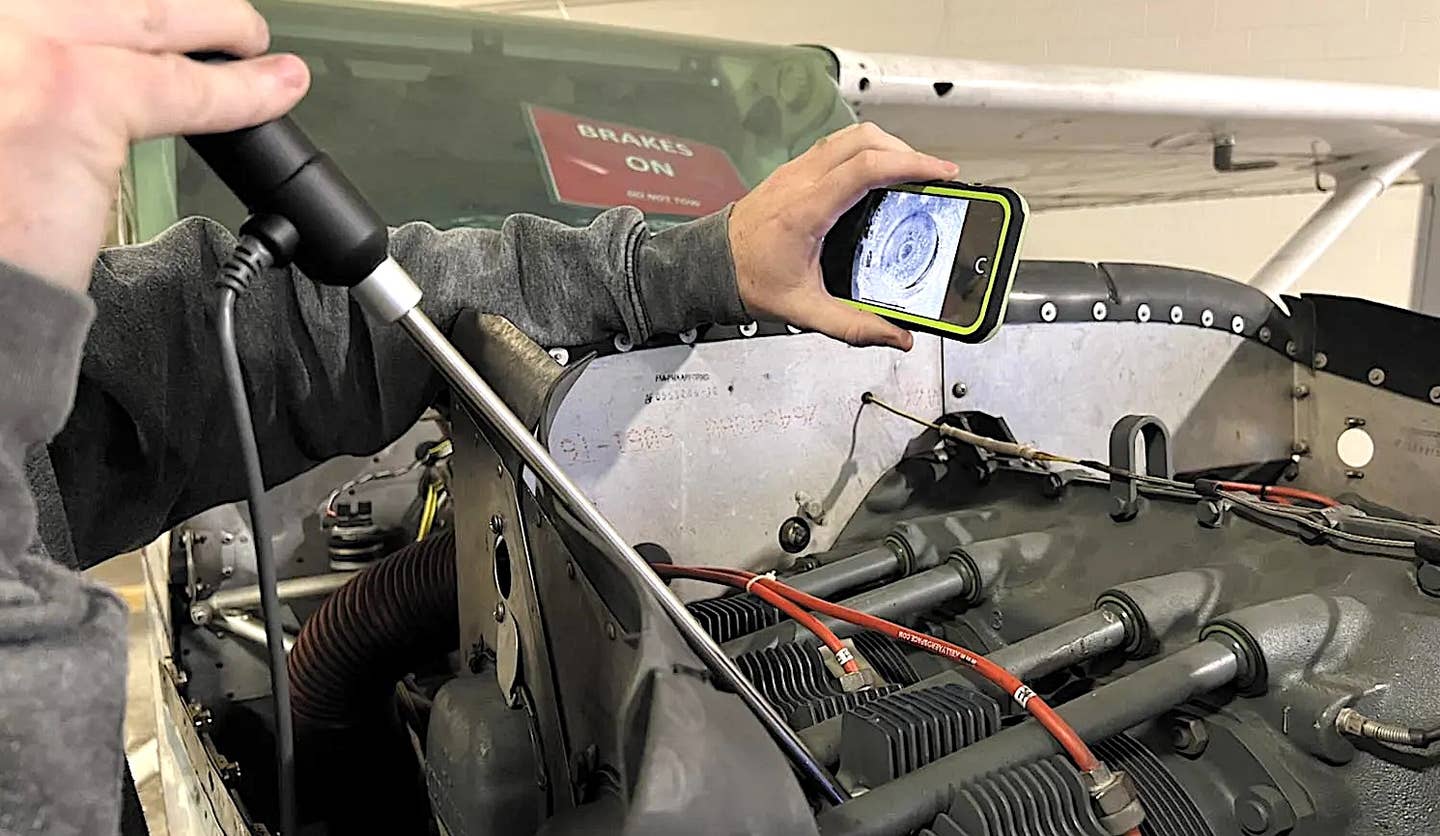Mobil AV-1 Under Attack
A class-action lawsuit demands that thousands of TCM 470-, 520-, and 550-series engines that used Mobil AV-1 synthetic oil be grounded for tear-down inspection and overhaul at Mobil’s expense. We urge owners not to panic.

 Even though Mobil AV-1 has been off the market for nearly a year,concerns about engine damage attributable the synthetic oil continueto skyrocket. Hundreds of former AV-1 users have submitted damageclaims to Mobil for premature cylinder wear, stuck rings, cloggedprop hubs and governors, and various other powerplant maladies.Mobil has been quietly reimbursing claimants for repairs, andsome owners have taken Mobil to court.
Even though Mobil AV-1 has been off the market for nearly a year,concerns about engine damage attributable the synthetic oil continueto skyrocket. Hundreds of former AV-1 users have submitted damageclaims to Mobil for premature cylinder wear, stuck rings, cloggedprop hubs and governors, and various other powerplant maladies.Mobil has been quietly reimbursing claimants for repairs, andsome owners have taken Mobil to court.
 The latest wrinkle is a voluminous class-action lawsuit filedin April, 1995, which seeks to force Mobil to notify owners ofthe thousands of Teledyne Continental 520- and 550-series enginesformerly operated on AV-1 oil that they should immediately groundtheir airplanes and submit their engines to a complete teardowninspection, and to require Mobil to pick up the tab for both inspectionand repair.
The latest wrinkle is a voluminous class-action lawsuit filedin April, 1995, which seeks to force Mobil to notify owners ofthe thousands of Teledyne Continental 520- and 550-series enginesformerly operated on AV-1 oil that they should immediately groundtheir airplanes and submit their engines to a complete teardowninspection, and to require Mobil to pick up the tab for both inspectionand repair.
This class-action suit is being brought by Malvern J. Gross, Jr.,a 60-year-old retired partner of the Price-Waterhouse accountingfirm who now lives in the San Juan Islands near Seattle. Grossis a 5,000-hour pilot, ex-president of the National AeronauticsAssociation, on the board of EAA, and has owned seven differentairplanes since he started flying in 1955. Armed with the resultsof teardown inspections of two low-time AV-1 engines and the testimonyof several world-class powerplant experts, Mal Gross appears determinedto get the word out that AV-1 can ruin engines, cause catastrophicengine failures, and jeopardize life and limb.
Gross's suit is being handled by Lieff, Cabraser, Heimann & Bernsteinof San Francisco, a law firm that specializes in large class-actioncases and participated in the $4.25 billion silicone gel breastimplant settlement, the $2.2 billion GM pickup truck settlement,and the $5.26 billion Exxon Valdez verdict. We'd guess Mobil istaking the suit seriously.
Unlike most of the owners suing Mobil, Gross doesn't appear tobe doing this for the money, but because he passionately believesthat his fellow aircraft owners must be warned of the grave dangerof continuing to fly behind an engine that may have been contaminatedby AV-1 use. On the day Gross filed his class-action suit, hislawyers sent a three-page press release plus the full 37-pagecomplaint to the editors of numerous aviation publications.
While we commend Gross for his good intentions and believe hehas an important story to tell, we're concerned that languageof his lawsuit will panic a lot of owners unnecessarily. AV-1oil had serious problems and undoubtedly damaged some engines.But we don't expect AV-1 engines to start falling from the skywithout warning, as the lawsuit might suggest.
Mal Gross's Experience
N210MG is a Cessna T210L that Gross purchased new in 1975. He'sput 2,900 hours on the plane since then. In November 1991, Grossbrought his airplane to Victor Aviation in Palo Alto, California,to have its Continental TSIO-520-R engine majored. Victor overhauledthe engine to new limits, and Gross picked up the airplane inJanuary 1992. After 30 hours, he drained the break-in oil andstarted using Mobil AV-1. He continued to use AV-1 until mid-1994,changing oil and filter every 50 hours.
During this period, a series of compression checks revealed adeteriorating trend of leakage past the rings. In September 1993,a mechanic removed the prop from Gross's T210 and found significantsludge accumulation in the forward hollow portion of the crankshaft,which he cleaned out.
When Mobil announced that they were withdrawing AV-1 from themarket in June 1994, Gross immediately switched to AeroShell W100and hoped his compression would start to improve. But checks inOctober 1994 and January 1995 showed further deterioration, withcompression readings in the low-to-mid 60s.
Gross decided to take the plane back to Victor Aviation for borescopeinspection in January 1995. The engine now had 590 hours SMOH.The borescope revealed signs of ring damage and excessive blow-by.Victor pulled the #5 jug and found the cylinder wall scored andthe oil control ring badly stuck as a result of sludge accumulation.They also pulled the prop and discovered a golfball-sized accumulationof sludge in the crankshaft. At this point, Victor recommendedremoval and inspection of all six cylinders, and Gross approved.
Gross also hired his own independent engineering consultant, Dr.Michael Wood of Aircraft Engine Failure Investigation, Inc., anda member of the well-respected aviation department of San JoseState University.
When Victor removed and inspected all six cylinders and lookedinside the crankcase, they were so alarmed by the extensive sludgedeposits that they advised a complete engine teardown to determinethe condition of the crankshaft and bearings. Dr. Wood concurredwith this recommendation, and Gross agreed to have it done.
The teardown revealed main bearings that were worn, crazed, andheat-distressed. Some showed evidence of shifting, and one bearingtang had scored the crankcase supports enough to require the caseto be sent out for repair. The oil transfer collar was scored.The lifter faces were pitted. All of this was evidence of lubricationfailure, and of an engine that might have failed catastrophicallyif it had been operated much longer.
Thick syrupy black sludge was. found coating the insides of thecrankcase, oil cooler adapter plate, crankshaft, and crankcaseoil galleys. John Pava of Victor believes this sludge contaminationexplains the lubrication failure that damaged the bearings andtransfer collar. Dr. Wood told Gross that he was "a verylucky man" for having had the engine torn down when he did.
Ronnie Eriksson's Story
Meantime, half a world away, a Swedish industrialist named RonnieEriksson was also having problems with the engine in his. 1988Beech B36-TC Bonanza. Eriksson is a 1,700-hour pilot and flieshis Bonanza all over Europe on business. Its Continental TSIO-520-UBengine was run exclusively on Mobil AV-1 oil after the factorybreak-in oil was drained.
Like Gross, Eriksson was concerned about a deteriorating trendof compression readings, and about the accumulation of lead sludgefound when the propeller was removed during routine maintenance.Eriksson was also plagued by high CHT and oil temperatures, forwhich he compensated by running the engine extra-rich.
In February 1995, with 633 hours total time on the airplane, Erikssonhad his engine crated and shipped to Victor Aviation for inspectionand repair. After receiving and inspecting engine, Victor informedEriksson that he was probably looking at a complete teardown andmajor overhaul which would ground his Bonanza for months. Erikssonjumped on an airliner and flew to California to assess the situationpersonally. He brought with him his own engineering consultant,Ulf Dahlquist, who had been Chief Inspector for the Swedish equivalentof the FAA. So Eriksson, Dahlquist, Wood, and Pava all wound upinspecting Eriksson's torn-down engine.
Dr. Wood characterized the innards of Eriksson's engine as theblackest and filthiest he had ever seen in his career. The casehalves, oil pan, suction screen, crankshaft bore, oil pump, andpiston domes all had extreme buildups of heavy black syrupy sludgesimilar to that seen in Gross's engine but worse. The oil controlrings were stuck, the main and rod bearings showed indicationsof lubrication distress. Dahlquist and Pava both reported severecam lobe wear and spalling, and at least one main thrust bearingworn completely through to the shell. All three experts agreedthat the engine would have been at risk of catastrophic in-flightfailure had it been continued in service.
Because Eriksson is not a U.S. citizen, he is not formally a plaintiffin the Gross v. Mobil lawsuit. But his engine and testimonyfigure prominently in the documents filed with the court.
A Long Time Coming
Mobil introduced its 100% synthetic AV-1 piston aircraft engineoil with great ballyhoo in connection with the 1986 round-the-worldVoyager flight. It went on the market in 1987, after five yearsof R&D and 25,000 hours of flight testing in 23 differentaircraft.. Teledyne Continental enthusiastically approved AV-1for use in all TCM engines with oil filters. It didn't take longbefore isolated cases of lead sludge accumulation became apparentin some (but certainly not all) engines using AV-1. Both John Frank of the Cessna Pilots Association andyours truly startedadvising against the use of AV-1 in low-utilization owner-flownairplanes as early as 1991. Our rationale was that 100% syntheticoil is a superb lubricant but a lousy cleanser, and that cleansingis extremely important in piston aircraft engines because of theirloose tolerances and the significant blow-by that can leak pastthe rings and contaminate the oil. But while we suggested ownersnot use AV-1, we honestly didn't anticipate that the lead sludgingproblem could reach the severity revealed by the Gross and Erikssonteardowns.
All the while, Mobil continued to promote AV-1 with an extremelyaggressive advertising campaign that made grandiose claims forthe product: "a cleaner engine with little or no sludge,a 200-hour oil change interval, up to 30% less oil consumption,10-15F cooler CHTs, and up to 5% fuel savings."Many knowledgeable engine people considered some of these claimsto be exaggerated commercial puffery, and most considered Mobil'ssuggested 200-hour oil change interval to be insane. But ownerslined up to buy AV-1 at eight bucks a quart.
Then, in a move that caught most observers by surprise (and delightedus), Mobil announced in June 1994 that it had decided to withdrawAV-1 from the market and to repurchase all existing inventorystocks. Mobil's press releases characterized this move as a marketingdecision.
At the same time, however, Mobil sent a letter to owners of TCM520- and 550-series engines stating that Mobil had just learned"during the past month" that in those engines "undercertain conditions, the lubricant is not dispersing lead fromthe fuel as well as had been predicted on the basis of originalflight and factory tests." Since then, Mobil has been quietlyprocessing and settling individual owner claims for AV-1 damage.(See "Mobil's Position.")Whydid it take so long for these problems to show up? The reasonappears to be that the most seriously affected engines were inowner-flown airplanes that flew only 100 or 150 hours a year.(See "Which Engines Are At Risk?")Ronnie Eriksson's Bonanza is a good case in point. Erikson startedusing AV-1 in 1988, not long after it went on the market. He experiencedsymptoms of severe wear at only 633 hours, but it took him nearlyseven years to accumulate those hours.
What We Think About This
It's important to keep all this in perspective. During the eightyears that AV-1 was on the market, thousands of owners used itand the vast majority had good luck and no mechanical problems.Some noted an abnormal accumulation of lead sludge when the enginewas torn down at overhaul, but most didn't. Only a relative handfulappear to have suffered accelerated wear. We are unaware of anycase of in-flight engine failure as a result of AV-1 use.
Nevertheless, we do not doubt that the Gross and Eriksson engineswere badly trashed and at serious risk of seizure had they continuedto be flown. And we do not dispute the suggestion that perhapsdozens or hundreds of other engines might be in the same boat.
The point is, however, that engines will almost surely exhibitclear warning signs of impending trouble long before internaldamage becomes severe enough to cause in-flight engine stoppage.This was demonstrably true of both the Gross and Eriksson engines,and of several other engines we've followed that had to be overhauledprematurely after using AV-1.
The contaminated engines all exhibited deteriorating compressionwithin 200-400 hours after starting AV-1 usage. Cylinder removalconsistently revealed abnormal top-end wear, stuck and sludge-fouledoil control rings, and a thick coating of black sludge on theunderside of pistons and on visible portions of the crankcaseinterior. Prop removal revealed a heavy accumulation of sludgein the hollow portion of the crankshaft and in the prop hub, andafter the sludge was flushed out, it often redeveloped within100 hours.
Consequently, it should be relatively easy for maintenance-awareowners of AV-1 engines to determine whether or not they are atrisk. The great majority of them will not be. The notion thatall AV-1 engines should be torn down as a precautionarymeasure seems to us like a colossal over-reaction.
We certainly don't want to sound like apologists for Mobil. Itis inconceivable that they weren't well aware of the lead scavengingproblems of AV-1 years before they withdrew it from the market.Mobil's own pipeline-patrol airplanes reportedly stopped usingAV-1 because it gummed up their engines. Mobil engineers surelyknew that Mobil marketing people were overstating the benefitsof the product. We think Mobil should have yanked AV-1 a lot soonerthan they did. Mobil should have come clean about AV-1's shortcomingsand publicly announced their damage compensation policy, ratherthan quietly dealing with disgruntled owners on a case-by-casebasis.
Mobil deserves to have their hands slapped over the AV-1 affair.But neither Mobil nor owners should be required to tear down orreplace an engine unless clear evidence exists that the particularengine is at risk.
Specific Recommendations
If you used AV-1 in your engine for 100 hours or more (whetheror not you're still using it or not), you should check compressionregularly (we suggest every 50 hours when you change oil) andbe alert for signs of deterioration. If you observe this, particularlyin a turbocharged engine, you might be well advised to investigatefurther for signs of abnormal lead sludge deposits. The easiestway to accomplish this is to pull the prop and look for sludgeaccumulations in the hub and crankshaft. If those areas appearclean, you're probably home free.
If the crank and prop appear to be fouled with black sludge, youmight borescope your cylinders or perhaps even pull off a jugor two and inspect for abnormal cylinder wear and sludge-fouledpistons and oil-control rings. While the cylinder is off, youcan inspect the inside of the crankcase for black deposits, andinspect the cam lobes for evidence of lubrication failure.
Another danger sign in an AV-1 engine is any abnormality in propelleroperation. Both Gross and Eriksson engines had badly scored transfercollars, and one owner we spoke to discovered that his enginewas lead-fouled only after discovering that he could not controlprop RPM.
Only if clear evidence of serious contamination is found wouldwe consider doing a precautionary engine teardown inspection.
Status of the Lawsuit
Gross et al. v. Mobil Corporation et al. was filed in earlyApril, 1995, in Federal District Court in San Francisco. Withlightening speed (by judicial standards), the Court certifiedthe class-action suit as a mandatory ("non-opt-out")class. According to our legal eagles, what this means is thatall U.S. owners of TCM 520 and 550 series engines that used MobilAV-1 are automatically parties to the lawsuit, and furthermorethe class action probably will be their only legal remedy againstMobil. While denying the claims of the plaintiffs, Mobil did notargue against the Court's certification of the class...probablybecause it protects Mobil against having to defend hundreds orthousands of individual legal actions.
The Court also granted the plaintiffs' request for an order requiringMobil to send letters to every TCM 520 and 550 owner of record,notifying them of the lawsuit and the plaintiffs' claims, andinstructing them how to contact the plaintiffs' law firm for moreinformation. (You can contact Lieff, Cabraser, Heimann & Bernsteinby telephone toll-free at 1-800-956-1009, by FAX at 1-415-956-1008, or byemail at lch@crl.com.)
In September, 1995, the Court granted a plaintiffs' motion toexpand the class to include owners of TCM 470 series engines aswell. Once again, Mobil stipulated to the motion without a fight.The Court also set a tentative trial date in November, 1995.
AVweb will continue to follow this situation closely andreport any further significant information as we receive it. Readerswith AV-1 experiences to report are encouraged to contact us byemail at editor@avweb.com.
Mobil's Position
When TCM 520- and 550- owners were notified in June 1994 thatit was pulling AV-1 from the market, Mobil's letter included an800-number for owners to call if they believed they had "anoil-related mechanical problem directly attributable to your useof AV-1."Mobil is now dealing with at least 250 acknowledgedowner claims of AV-1 engine damage, and we suspect the numberis likely a good deal higher. At first, calls to the 800-numberwere being handled by John Esser and Frank Feinberg of Mobil'smarketing company, Mobil International Aviation and Marine Sales,Inc. Later, claimants were referred to R. C. Gronwaldt in MobilCorporation Claims.
Owners who called Mobil were sent a claim form and asked to submitphotocopies of logbook pages, maintenance invoices, photographs,and other proof of the legitimacy of their claim. Some were askedto send Mobil pistons or other parts for inspection.
Most bona-fide claimants were quietly and politely offered reimbursementfor a top overhaul, pro-rated to TBO. Many owners accepted thisoffer. Some who made a fuss were offered reimbursement for majoroverhaul or a factory reman (again, pro-rated to TBO) plus propand governor overhaul and engine R&R labor. Mobil has consistentlyrefused to compensate claimants for aircraft downtime, nor forengine mount or hose replacement or turbocharger and controlleroverhaul.
One owner we talked to has had his aircraft down for more thansix months. Mobil offered to settle with him for nearly $18,000covering a $26,000 factory reman pro-rated to TBO plus prop, governor,and R&R. This owner, whose airplane is extremely criticalto his business, refused Mobil's offer and is suing.
To date, Mobil's handling of AV-1 claims has been strictly ona "squeaky-wheel" basis. Mobil has not notified ownersthat AV-1 might have damaged their engine, nor publicized thefact that Mobil is offering some reimbursement for engine repairsand replacement.
To claimants, Mobil admits that they are aware of cylinder damage,stuck rings, and contaminated propellers and governors resultingfrom inadequate lead scavenging by AV-1 oil. But Mobil apparentlyinsists to this day that they know of no case in which bottom-enddamage was directly attributable to AV-1, and dismiss as "impossible"the idea that AV-1 users might face increased risk of in-flightengine failure.
Mobil also contends that top-end damage attributable to AV-1 isstrictly to confined to TCM 520- and 550-series engines, and hasso far has refused (we're told) to accept claims from owners whoused AV-1 in 360s and 470s or in any Lycoming engine. We are ata loss to explain how Mobil rationalizes this position.
While most of the owners we talked to had elected to accept thesettlement offered by Mobil, a few did not feel they were beingtreated fairly and are going to court in hopes of obtaining whatthey considered to be full and fair compensation. We have no wayof knowing at this point just how many owners are suing Mobilover AV-1, but the number of lawsuits is probably significant.
Which Engines Are At Risk?
Why were some engines so severely contaminated by AV-1 while mostremained clean and healthy? Nobody really knows the answer yet.But we can make some educated guesses.
It's important to understand the mechanism at work here. Syntheticoil like AV-1 is composed of long, smooth polymer molecules thatdon't have all the little side branches that petroleum polymersdo. This makes them extremely slippery and gives them excellentlubricating properties. Synthetic oils also lack the "lightends" of petroleum oils that can break down under extremeheat and create varnish and carbon deposits.
But it's those same smooth, ultra-slippery molecules that givesynthetic oil its Achilles' heel: the inability to hold lead saltsand other contaminants in suspension. The synthetic oil moleculesare simply too damned slippery to hang onto such contaminants,so they settle out of solution and form sludge deposits, particularlyin areas of oil stagnation such as prop hubs, oil pans, and theinside of pistons.
Tetraethyl lead is an octane enhancer used in avgas. It doesn'tbelong in the oil. Two compression rings on each piston seal thecombustion chamber and keep combustion confined to where theybelong. As long as the rings do their job well, the lead willgo out the exhaust pipe and the oil will stay relatively lead-free.
But if combustion byproducts leak past the compression rings,a vicious cycle can begin. The third piston ring is the oil controlring, a spring-loaded slotted ring that receives oil from tinyfeed holes in the piston and is responsible for spreading an oilfilm on the cylinder walls. If exhaust blows by the compressionrings and fouls the oil control ring, its ability to lubricatethe cylinder walls is compromised. Lack of lubrication resultsin accelerated wear of the cylinder and rings, further reducingcompression and creating more blow-by. Within a few hundred hours,the compression may be down to the low 60s and the engine maybe filthy with gooey black sludge. Some blow-by is inevitable,and engine oil is supposed to hold a reasonable amount of contaminationin suspension so it may be drained out at the next oil change.Unfortunately, AV-1 didn't do this as well as petroleum-base oils.
We believe that AV-1 engines that exhibit good compression testresults are probably not at much risk of sludge formation andsludge-induced lubrication problems. Engines that exhibit earlydeterioration of compression are at greatest risk.
Turbocharged engines appear to be much more likely to be contaminatedbecause their higher combustion chamber pressures make blow-bymore of a problem. The Gross and Eriksson engines were both turbo'd,and every owner we talked to in researching this article turnedout to have a turbocharged engine. Ironically, AV-1 was especiallypopular among owners of turbos because of its resistance to cokingunder high heat.
It looks to us as if low-utilization engines (typical of mostowner-flown aircraft) are more likely to be contaminated thanones that fly every day (such as Part 135 operators). The oilfilm on cylinder walls tends to strip away during periods of disuse,resulting in cylinder wall corrosion and metal-to-metal scuffingat the next engine start. Hence, low-utilization engines tendto wear cylinders faster.
At oil-change time, the sump should be drained immediately afterflight while the oil is still hot and agitated. Otherwise, contaminantshave time to settle out of suspension and form sludge deposits.This is good practice for all kinds of oil, but was especiallycrucial with AV-1.
The use of extended oil change intervals (as touted by Mobil'sadvertising) would have made the problem much worse. We spokewith a few owners who changed their AV-1 at 100-hour intervals,although most changed every 50 hours.
Finally, proper leaning is very important. Rich mixtures greatlyaggravate the lead sludging problem because the fuel is not completelyburned and the exhaust gas is loaded with lead and other unburnedbyproducts. This was clearly a contributing factor for Eriksson.






